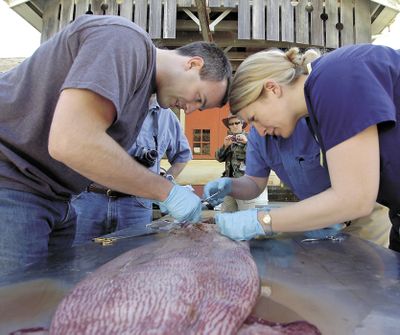Surgeons fix dead squid for display at museum

CHARLESTON, Ore. – The patient needed just a nip and a tuck – nothing three experienced plastic surgeons couldn’t handle. But the patient in this case was a 12-foot Pacific giant squid, and already dead.
On Friday, surgeons hunched over a gelatinous carcass, laid out like a wet dress on a stainless steel table outside the Oregon Institute of Marine Biology. Their mission: Stitch up its battle wounds and reattach its head.
OIMB’s director, Craig Young, said the goal was to make the creature a presentable attraction at the future Charleston Marine Life Center.
Plans call for a 6,000-square-foot, two-story public museum and aquarium. The squid will be preserved and displayed in a tank of formalin.
Young recruited only the best for the operation: Dr. Ernie Manders, a renowned professor of surgery at the University of Pittsburgh, and his colleagues Drs. Christine Fisher and Galen Wachtman. The team sewed up the squid’s jelly-like tissue with surgical precision.
Manders established a relationship with OIMB while researching the unique regenerative properties of certain marine animals. Sea stars, for example, can regrow severed limbs.
This type of creature may hold the key to new medical advancements, such as instant conductivity of nerves in transplant surgeries.
“All the basic nerve physiology they enjoy, we enjoy,” Manders said.
Young tapped Manders for the squid job while the surgeon pursued his research at the OIMB campus.
“It occurred to me we might be able to get some free service out of him as a plastic surgeon,” Young said.
Manders and his surgical team needed less than two hours to make the cephalopod whole again.
The beast had sustained 4-foot-long gashes from a fisherman’s gaff when it was caught near Bandon. The specimen was donated for research at OIMB, where its head eventually fell off in a freezer.
Though frozen for two years, it was thoroughly thawed for Friday’s surgery.
“This is coming together nicely,” Manders enthused.
“We do some pretty cool stuff around here,” Beardsley said.